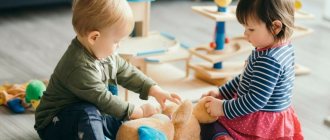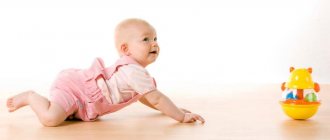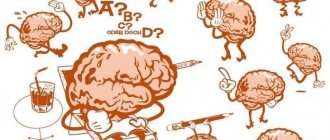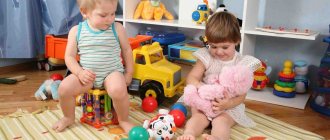Newborn crisis
The process of birth is a difficult, turning point in the life of a child. Psychologists call this period the neonatal crisis.
Causes of the neonatal crisis: - Physiological (being born, the child is physically separated from the mother. He finds himself in completely different conditions: cold, bright light, an air environment that requires a different type of breathing, the need to change the type of nutrition). — Psychological (the psyche of a newborn child is a set of innate unconditioned reflexes that help the child in the first hours of his life). What unconditioned reflexes does a newborn have? These are, first of all, breathing and sucking reflexes, protective and orientation reflexes. Some reflexes are atavistic (“catching”) - they are received from animal ancestors, are useless for the child and soon disappear. The child sleeps most of the time.
Psychological characteristics of the newborn period
The child has sensitivity: distinguishes salty, bitter, sweet taste; reacts to sound stimuli. Important events in the mental life of a child - the emergence of auditory and visual concentration
.
Auditory concentration appears at 2-3 weeks. A sharp sound, for example, a door slamming, causes a cessation of movements, the child freezes and becomes silent. Later, at 3-4 weeks, the same reaction occurs to a person’s voice. At this time, the child not only focuses on the sound, but also turns his head towards its source. Visual concentration, which appears at 3-5 weeks, is externally manifested in the same way: the child freezes and holds his gaze (of course, not for long) on a bright object. A newborn, having acquired the ability to respond to the voice of the mother caring for him, to see her face, establishes emotional connections with her. At about 1 month, the baby, seeing his mother, fixes his gaze on her face, throws up his arms, quickly moves his legs, makes loud noises and begins to smile. This violent emotional reaction has been called the “animation complex.”
The animation complex, which includes a truly human characteristic - a smile - marks the emergence of the first social need - the need for communication. And the development of a child’s need for communication means that in his mental development he moves from newbornness to infancy itself.
Question 2: Newborn reflexes
Newbornhood is the only period in a person’s life when natural, instinctive forms of behavior can still be observed in their pure form. Therefore, it is possible to understand what nature gives to a child by studying this particular age.
A baby is born with a certain supply of innate unconditioned reflexes, i.e. automatic, involuntary responses to certain external stimuli. And although his nervous system is still far from formed, it is ready to adapt the body to external conditions.
Among the innate reflexes of a newborn there are functional
, which are absolutely necessary for his survival in the outside world, helping the child adapt to new living conditions. So, immediately after birth, reflexes are activated that ensure breathing and blood circulation. This group also includes the so-called protective reflexes, which protect the body from dangerous and too strong influences. Thus, severe skin irritation (for example, an injection) causes the child to withdraw his arms or legs; a sharp increase in light brightness causes constriction of the pupil (pupillary reflex); In response to a flicker of light or a puff of air, the baby squints or closes his eyes (blink reflex).
These reflexes are essential for physical survival and persist throughout a person's life.
The most important functional reflex for a newborn is the sucking reflex. If you touch an object (for example, a finger) to the baby's mouth, he immediately begins to suck on it. And if you touch his cheek, he will turn his head towards the stimulus and, with his mouth open, will look for his mother’s breast. This turns on the search reflex. These reflexes ensure that the child is ready for a new type of nutrition.
12 pp., 5894 words
Psychological climate in a family raising a child with special needs...
... a child with special needs of psychophysical development. Research objectives: ) carry out a theoretical analysis of the literature on the research problem; ) consider the characteristics of the emotional state of parents raising children with special needs of psychophysical development; ... a favorable family climate is marital relations. Living together requires spouses to be willing to compromise, to be able to...
However, not all reflexes of a newborn have vital adaptive significance. Among them there are those who do not play any role in the child’s life. The most striking example of this is the so-called Robinson reflex (or grasping reflex).
Touching a baby's palm produces a grasping reaction that is surprisingly strong for a newborn. For example, if you touch his palms with your fingers, he will grab them so tightly that he can hang, holding on to them, like a monkey. This also includes the stepping reflex - if the baby’s foot touches any surface, he begins to make stepping movements with both legs, as if he were walking. Reflexes that are equally useless for the life of a newborn include the crawling reflex (touching the soles of the feet causes a reflex repulsion); hand-throwing reflex (or Moro reflex - if the baby is in danger of falling or in response to a strong sound, he sharply raises his hands up and quickly lowers them, while his palms seem ready to grab something); cervical-tonic reflex - when the head of a child lying on his back is turned to the side, he extends the arm and leg on the side of the body where the head is turned and bends the opposite arm and leg, which resembles a fencer's pose. Recently, the swimming reflex of a newborn has been discovered: if he is lowered into water, he will not drown, but will flounder and stay on the water.
All these are so-called atavistic reflexes. They represent the inheritance received by the child from his animal ancestors. It is characteristic that most of them fade away already in the first half of life. For example, the Robinson reflex weakens significantly by the fourth month of life, before a purposeful act of grasping occurs. The step reflex disappears at 3–4 months, long before the child begins to walk. The crawling reflex when resting on the soles is also not the basis for independent movement in space. As observations have shown, infant crawling begins not with pushing off with the legs, but with movements of the arms. Unconditioned reflexes of newborns do not by themselves ensure the emergence of human forms of behavior. In contrast, a set of unconditioned reflexes of young animals is a necessary natural basis for the behavior of an adult with active protective, hunting, maternal and other forms of behavior necessary for its normal existence.
At the same time, these unconditioned reflexes of the newborn can be included in other, more complex and purposeful forms of behavior of the child. For example, the sucking reflex, since it is constantly exercised in a situation of interaction with the mother, at 2–3 months. turns into a purposeful and regulated action of the infant. The child stops sucking everything, he begins to regulate the rhythm and intensity of sucking. It can stop when you are full or start when you see a pacifier or bottle. The same goes for the grasping, stepping or swimming reflex. If they are constantly trained and included in a situation of interaction with an adult, these movements can be preserved and become part of more complex actions (walking, grasping and holding an object, etc.).
9 pages, 4066 words
Classification of brain tumors in children
... classifications are based on this principle. Brain tumors diagnosed in children in the first years of life have a central location, i.e. most often affect the third ventricle, hypothalamus, ... chiasma of the optic nerves, midbrain, pons, cerebellum and fourth ventricle. Despite...
However, these reflexes themselves will never develop into human forms of behavior, which are formed on a completely different, non-reflexive basis.
A newborn has another group of reflexes, which, although they have no vital significance, do not fade with age, but, on the contrary, become stronger. These are indicative reflexes
, aimed at contact with external influences. It has been established that already on the first day of life, a strong light source causes the baby’s head to turn: in the children’s room of a maternity hospital on a sunny day, the heads of most newborns are turned towards the light, like sunflowers. The newborn also reacts to a strong sound by turning its head towards its source. Unconditioned orienting reflexes are the basis of the need for impressions, which manifests itself already in the first days of life.
By the end of the first month of life, the first conditioned reflexes
. In particular, the baby begins to respond to the feeding position: as soon as he finds himself in a certain position on the mother's lap, he begins to suck.
Emotional communication with an adult as the leading activity of an infant
The leading activity of infancy is emotional communication with adults. A child at this age is weak and completely helpless. Although, upon being born, he was physically separated from his mother, he was still biologically connected to her. He cannot satisfy any of his needs on his own: he is fed, bathed, dressed in dry and clean clothes, moved in space, and his health is monitored. And finally, they communicate with him. Such helplessness and complete dependence on an adult constitute the specificity of the social situation of an infant’s development. The need for communication in a child appears early, at about 1 month, after the neonatal crisis (according to some sources, at 2 months). The revival complex upon the appearance of the mother (or another loved one caring for the child) indicates the emergence of a need for communication, which should be satisfied as fully as possible. Direct emotional communication with an adult creates a joyful mood in a child and increases his activity, which becomes a necessary basis for the development of his movements, perception, thinking, and speech. What happens if the need for communication is not satisfied or is not satisfied enough? Children who end up in a hospital or orphanage are lagging behind in mental development. Until 9-10 months, they maintain a meaningless, indifferent gaze directed upward, move little, feel their body or clothes and do not try to grab toys that catch their eye. They are lethargic, apathetic, and have no interest in their surroundings. They will have speech very late. Moreover, even with good hygienic care, children lag behind in their physical development. These severe consequences of lack of communication in infancy are called hospitalism.
The main lines of a child’s mental development
Sensory development: visual concentration, which appeared at the newborn stage, is improving. After the second month, concentration becomes quite long; by 3 months, its duration reaches 7-8 minutes. At this age, the child determines the shape of objects and reacts to color. The child can track moving objects. At 4 months, he not only sees, but actively looks: he reacts to what he sees, moves and squeals. A child's cognitive development is facilitated by the variety of impressions he receives. Adults caring for a child must satisfy his need for new experiences.
, trying to ensure that the environment around him was not monotonous and uninteresting. The cognitive development (primarily the development of perception) of infants living in a monotonous environment turns out to be somewhat slower than the development of those who receive many new experiences.
Development of movements and actions:
Time of occurrence of movements
| Motor development | |
| 1 month | Raises chin |
| 2 months | Raises the chest |
| 3 months | Reaches for an object, but usually misses |
| 4 months | Sits with support |
| 5 - 6 month | Grabs objects with hand |
| 7 months | Sits without support |
| 8 months | Sits down without assistance |
| 9 months | Stands with support: crawls on stomach |
| 10 months | Crawls, leaning on hands and knees; walks holding with both hands |
| 11 months | Stands without support |
| Year | Walks holding on with one hand |
1 month - chaotic movement of the hands, fingers clenched into a fist; 2 months - clenching and unclenching fingers. An object placed in the hand is held with the entire palm for 2-3 seconds. 3 months - holds an object placed in the hand for up to 10 seconds, pulls it into the mouth. 4 months - palms are often open, hands are extended towards an object, finger movements are not differentiated. 5 months - opposes the thumb to the others, parts of the fingers dominate when grasping objects. 6-7 months - the child waves the objects he has grabbed, knocks, throws and picks them up again, bites, moves from hand to hand, etc., the movements of the fingers are differentiated. 8-9 months - takes small objects with two fingers, and large ones with the whole palm, shows his nose, eyes, waves his hand when saying goodbye, tightly squeezes the toy that is taken away. 10-11 months - manipulates objects, first functional actions
, allowing for relatively correct use of objects, imitating the actions of adults (a child rolls a car, beats a drum, brings a cup of juice to his mouth).
Speech development: Already in the revitalization complex, the child shows a special interest in the speech of an adult addressed to him. In the first half of the year, speech hearing is formed, and the child himself, with joyful animation, makes sounds, usually called humming
.
In the second half of the year, babbling appears, in which it is possible to distinguish some repeating sound combinations, most often associated with the actions of the child. Babbling is usually combined with expressive gestures. By the end of 1 year, the child understands
10-20 words spoken by adults, and he himself
pronounces
one or several of his first words that sound similar to the words of adult speech.
Question 3: Features of sensory development
How can you describe the mental life of a newborn? A newborn baby probably seems completely helpless to you. How can he understand the world if he is not even able to lift his head? But it is precisely in the first weeks of life that the child has unique sensory abilities, which after a few months will begin to fade, and by the year they will practically disappear.
Study by Bronstein and Petrov: children were observed from a few hours to 8 days old. The technique was that the newborn was presented with various stimuli, and the indicator of discrimination ability was inhibition of the sucking reflex.
The results revealed that newborns not only respond to stimuli, but are also able to distinguish their intensity.
Sounds that differ from each other by more than 1 octave are distinguished by 89% of subjects. A difference of one 1 octave is 70%, less than 1 octave is 40%.
The location of the sound on the right or left is also distinguished.
Color sensitivity: only 37% of children react to changes in color, and only extreme colors (green-red).
Taste and olfactory sensitivity are detected 1.5 hours after birth.
Tactile sensitivity is distributed unevenly: the most sensitive areas are the lips, palms, and forehead.
The child distinguishes temperature (10 degrees different from the usual temperature can lead to refusal of food).
Ψ: It is believed that the skin is the main channel of communication with the outside world during this period. Advice: if you want your baby to develop intelligence from the very first days, try to let him spend as much time naked as possible. It is especially important that the arms to the elbow and legs from the foot to the knee are open - this is where the most susceptible areas of the skin are located.
13 pages, 6323 words
The difference in popularizing the development of a healthy lifestyle among...
... urban environment .2 The main problems of the development of sports in rural areas and ways to combat them. Study of a healthy lifestyle among children and adolescents in urban and rural areas. Conclusion List of references Introduction Relevance. In accordance with the Concept of long-term socio-economic development of the Russian...
Important events in the mental life of a child - the emergence of auditory and visual concentration
. Auditory concentration appears at 2-3 weeks. Sounds cause movements to cease, the child freezes and becomes silent. Later, at 3-4 weeks, the same reaction occurs to a person’s voice. At this time, the child not only freezes, but also turns his head towards the source of the sound. Visual concentration appears at 3-5 weeks; it manifests itself in the same way: the child freezes and fixes his gaze on a bright object.
In general, mental life is associated mainly with subcortical centers, as well as with an insufficiently mature cortex. Ψ: at the time of birth, the weight of the brain is 389 g, by the age of 1 year it increases to 890 g (an increase of +501 g).
For brain development, a child needs as much stimulation as possible. This is explained by the peculiarities of the morphological structure of the NS. A newborn's sensations determine the architecture of his brain. Every new experience is reinforced through brain connections, helping to build new connections between brain cells. Under the influence of the flow of sensory sensations delivered by early life experiences, a nervous network arises, the more complex of which is unlikely to be found in the entire universe. But if the brain receives too few external impressions, “excessive” connections are eliminated, and with them future opportunities. Ψ: manifestation of this pattern in animals: in animals growing up in conditions of impoverished visual experience, the visual centers of the brain lag behind in development, the bodies of neurons are reduced, their processes are shortened and the development of pathways slows down. Children with disturbances in the functioning of their sensory organs have deviations in the characteristics of the bioelectrical activity of the brain.
Reputable brain researchers now share the view that the emotional and sensory development of the newborn child is critical to its later learning abilities [4].
The process of development of the nervous system and the brain as its part is determined by the hereditary program, as well as impressions, experiences and training received in early childhood. The most basic functions of the brain are determined genetically, in the trunk of which synapses are formed that allow the functioning of all internal organs - heart, lungs, liver, etc. Today it is estimated that of the 80,000 different genes, approximately half determine the development, formation and control of the central nervous system. This number limits the effect of heredity - further development of the brain occurs under the influence of external stimuli and learning. The hereditary program strictly determines only the order of development of brain zones, and the degree of their development is determined by the action of external stimuli.
Thus, it becomes increasingly obvious that hereditary inclinations and experience are in constant interaction. Powerful stimuli from the surrounding world, through carrier substances, can even affect the nuclei of cells and thereby influence the activity of genes.
The baby learns what abstract concepts mean through the senses. “Later” is a tense, if not anxious, time of waiting. “More” can mean super-pleasure, but also an unpleasant feeling. “Close” means clinging closely to the mother. Before a child can count, he needs "sensory understanding" to gain an understanding of extension, duration, and magnitude. This will become a prerequisite for logical thinking [12].
7 pages, 3272 words
Development of the psyche in phylogenesis. The emergence and development of consciousness...
... vertebrates develop the spinal cord and brain - the central nervous system. Simultaneously with the development of the nervous system and receptors, ... more complex perception and strong memory are improved. The emergence and development of consciousness The development of the psyche in phylogenesis led to the emergence of its highest ... is formed under the condition of human life in society (children - Mowgli have no consciousness) and besides, it ...
Later, the child will be able to connect various sensory experiences into a single complex image. But a newborn child still cannot interpret the flow of incoming information. To do this, he needs some kind of organizing force that would give meaning to his sensations. This power is nothing more than a feeling.
Emotional evaluation of new sensory sensations occurs in the limbic system of the brain. They are compared with those impressions that have already been accumulated in the cerebral cortex and, if they turn out to be new and important, they are deposited there. Based on these sensations, it becomes possible to formulate further appropriate actions. For this cycle to occur, the individual brain participants must be securely connected to each other.
Neoplasms of infancy
New formations: elementary forms of perception and thinking. First independent steps, words. An active need to understand the world around us. With the appearance of the first words, a new stage in the child’s mental development begins. Between infancy (0-1) and early childhood (1-3) there is a transition period called the “1 year crisis”
External manifestations of a crisis: a child develops affective reactions when an adult does not understand him or forbids him to do something. The child becomes restless, manifestations of independence appear. Internal causes of the crisis: the growing contradiction between the needs for knowledge of the world around us and the capabilities that the child has. Capabilities are still insufficient to meet needs. The main acquisition of the transition period is the peculiar children's speech, which L.S. Vygotsky called it autonomous. It differs significantly from adult speech; its sound sometimes resembles “adult” words, and sometimes differs sharply from them (av-av - dog, titi - clock).
Parshukova Inga Alekseevna.
Moscow, Siberian State Transport University, student,
Infancy is a period in which the development of a child in physical, mental and social terms occurs extremely quickly, covering in a short period of time a huge path from a helpless newborn with a small set of innate reactions to an active baby who is able to look, listen, act, cry for help , rejoice [1, p. 24].
It is known that the period of infancy consists of two phases (the first lasts up to 5-6 months, the second lasts up to 12 months) and ends with a crisis of one year.
The mental development of a child during infancy is determined by the fact that he is biologically and socially helpless and has minimal opportunities for communication and interaction with others. Therefore, the main direction of a child’s development at this stage is mastering the basic ways of interacting with the world.
The first phase of infancy is characterized by the active development of sensory systems, i.e. elementary forms of future orienting reactions, such as concentration, tracking, circular movements. At 4 months, a reaction to novelty appears; it consists, in particular, in the duration of holding the gaze on a new object. There is also the development of auditory perception (reaction to the mother’s voice) and tactile sensitivity, which is of great importance for the formation of the act of grasping and examining an object.
The development of a child’s vocal reactions manifests itself in the form of attempts to attract an adult through the voice, which indicates the process of restructuring vocal reactions into behavioral acts. At this time, the child exhibits various types of vocal reactions, which include hooting, humming, and babbling.
With the onset of the second phase of infancy (at approximately 5 months), a “turning point” occurs in the child’s development. Its beginning is characterized by the appearance of the first directed action - the act of grasping. For the mental development of the child, this act is extremely important, since in connection with it, objective perception arises.
Thanks to the act of grasping, the perception of space deepens (the space of an outstretched arm). Although its distance is small, at the same time, the object breaks out of the previous scheme (the perception of spatial characteristics previously occurred through the mouth).
Based on the active development of the hand, which consists of opposing the thumb, the child’s ability to manipulate an object expands. Therefore, at the age of 4 to 7 months, the child begins to perform effective actions, which is manifested in simply moving an object and extracting sounds from it.
By 7–10 months, correlative actions are formed, i.e. the child learns to interact with two objects at the same time, moving them away from himself or relating them to each other.
By the end of the infancy period (from 10-11 to 14 months), functional actions occur. These actions are characterized by more advanced movements: opening, inserting, stringing. Moreover, if previously the child carried out an action in one way, which was shown to him by an adult and performed this action on the same objects, now he attempts to reproduce the action on all kinds of objects [4].
The act of grasping stimulates the child to sit. Many other objects open before him, and objects appear that he cannot reach. This is where the law of the child’s advance acquaintance with the world comes into force. Due to the fact that the child reaches out to an object, but can only get it with the help of an adult, communication takes on a different character, it becomes communication about objects.
From the second half of life, adult help (organization of actions, approval) is important. This leads to the need for new means and ways of influencing adults. This is how a pointing gesture arises, which is already objectively related and contains the rudiments of a word.
L.S. Vygotsky determined that initially the pointing gesture is an unsuccessful act of grasping movement: the child wants to take an object that is too far from him and his hands, extended to the object, remain hanging in the air, and his fingers make pointing movements. Understanding the child's movement as a pointing gesture occurs when the mother comes to his aid. After this, the situation changes significantly and this gesture already becomes a gesture for others. That is, an unsuccessful grasping action of a child causes a reaction not from the object, but from other people. And only subsequently does the child begin to treat this movement as an instruction. The child is the last to realize his gesture [2, p. 101–104].
This process illustrates that the joint action of a child and an adult lies at the origins of the emergence of a word.
The child’s first understanding of words occurs towards the end of infancy, and an adult has the opportunity to control the child’s orientation based on his understanding of speech.
Between infancy and early childhood there is a transition period - the “one-year crisis.” The crisis begins at 9 months, at which time the child begins to walk. According to D.B. Elkonin, the main thing in the act of walking is not only the expansion of the child’s space, but also his separation from the adult. Now there is a division of “we” and for the first time it is not the mother who leads the child, but he who leads the mother wherever he wants. Walking is the first major neoplasm of infancy, which marks a break in the old developmental situation [5, p. 159].
The appearance of the first word represents the second major new formation characteristic of this age. The first words are different in that they are a continuation of pointing gestures. The beginning of walking and the gradual enrichment of objective actions create a need for speech that could satisfy communication about objects. At this stage, speech is a specific structure, which consists of fragments of words, is emotionally charged and understandable only to those close to you. Nevertheless, it serves as a criterion for the emergence of a new developmental situation: where there was unity, two appeared - an adult and a child. Between them a new content of activity arose - the world of human objects.
The third, main new development during infancy is the appearance of manipulative actions with objects. The child still has to learn to interact, master ways of acting with human objects that surround him everywhere. For now, the child has to focus on the physical properties of these objects. The exit from the old developmental situation is accompanied by the manifestation of the child’s negative emotions, which arise in the form of a response to a certain limitation of his physical independence. L.S. Vygotsky gave this behavior the name “hypobulic reactions,” that is, protest reactions in which the differentiation of will and affect has not yet occurred.
Describing the crisis of the first year of life, L.S. Vygotsky explains it by the appearance of autonomous child speech. It leads to a change in the child’s attitude towards the environment, thereby bringing into being a new developmental situation. “Speech in relation to the child’s social space plays the same role as walking in relation to the physical space” [3, p. 150].
This period is characterized by the child’s desire for independence and at the same time complete dependence on the adult, which is the main contradiction of the crisis of the first year.
Thus, this stage of child development is characterized by the fact that from the very beginning there are two interconnected lines of mental development: the formation of orientation in the meanings of human activity and the formation of orientation in the methods of human activity. Mastering one line opens up the possibility of developing another.
Thus, the main task of raising a child during infancy is the maximum expansion and development of the child’s broad orientation in the surrounding reality.
In view of the fact that emotional communication is the main type of activity of a child during infancy, it is extremely important to satisfy the first need that develops in a child - the need for another person.
To develop a child’s sense of trust in the world, adults need to communicate with him, since, with correct and sufficient communication between a child and an adult, the phonemic composition of babble forms the phonemic composition of native speech. In this case, communication should be emotionally positive.
Taking into account the above, we can conclude that the period of infancy is an important period during which the rapid formation of all mental processes occurs in the shortest possible time.
Bibliography:
- Vallon A. Psychological development of the child. - M.: Education, 1997. - 195 p.
- Vygotsky L.S. Questions of child psychology. - St. Petersburg: Soyuz, 2006. – 224 p.
- Vygotsky L.S. Pedagogical psychology. - M.: Education, 2008. - 300 p.
- Obukhova L.F. Developmental psychology: a textbook for universities. – M.: Higher education; MGPPU, 2009. – 460 p.
- Elkonin D.B. Introduction to developmental psychology. - M.: Nauka, 2009. - 168 p.










